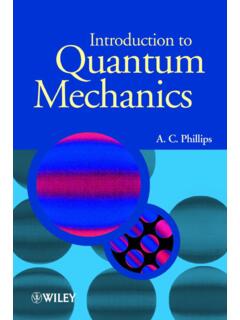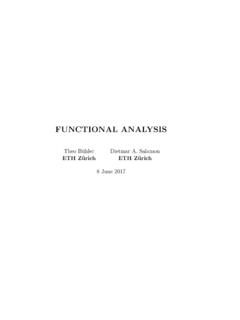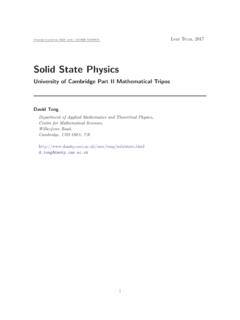Transcription of Density Functional Theory for Beginners - Attaccalite
1 Density Functional Theory for Beginners Basic Principles and Practical Approaches Fabio Finocchi Institut des NanoSciences de Paris (INSP). CNRS and University Pierre et Marie Curie October 24, 2011. 1. To the memory of Elena, who made me feel any small progress along the completion of these notes extremely important. Contents 1 Introduction 2. 2 Basic DFT Theory 5. Why is the problem difficult .. 5. Functionals .. 6. Electron Density as the basic variable .. 7. Towards the definition of the energy Functional .. 9. Finding the ground state: total energy and electron Density .. 11. Minimizing E[n] .. 11. The Kohn-Sham equations .. 13. Computing the total energy .. 15. The Exchange-Correlation energy Functional .
2 16. 3 Practical Implementation 20. Solving the Kohn-Sham equations: basis sets .. 20. Pseudo-potentials .. 22. Plane waves .. 23. Solving the Kohn-Sham equations: the self-consistent cycle .. 30. 4 Density Functional Perturbation Theory 34. The basic formalism.. 34. First-order energy derivatives and atomic forces.. 35. Second order .. 38. 1. chapter 1. Introduction Numerical Simulations and Materials Science Physicists have a talent for producing equations that they are quite unable to solve. This is likely the basic reason why numerical simulations have become ubiquitous in most fields of physics, including materials science, condensed matter physics and nano-sciences.
3 Experiments can often be difficult to carry out, expensive and sometimes provide only indirect information. For instance, X-ray diffraction must be complemented by appropriate computer programs in order to find out atomic positions in a complex crystal. Moreover, X-ray diffraction can identify where atoms are, not why the actual structure is preferred to another one. The interpretation of the experimental data often requires hypothesis or models that should be validated independently. Numerical simulations can provide a valuable help to explain the experimental data on the basis of a microscopic model and give insights into the basic mechanisms of interaction between atoms.
4 Simulations can also be useful to obtain the numerical solution of equations that cannot be solved by analytical means, and provide benchmarks for approximated theories or simplified models. The standard use of numerical simulations is ultimately due to the fast improvements of the computer power and the development of new and more and more effective numerical methods. As far as materials science is concerned, some important dates must be recalled. 1. The invention of the first device that resembles modern computers in the 40's;. 2. N. Metropolis proposed a new algorithm, based on the Monte Carlo method, (1) to sample a statistical distribution (2). It is worth noting, in this respect, that these methods benefited from algorithm for generating pseudo-random numbers and the fast development of computing power.
5 3. In 1959, Alder and Wainwright proposed a way to integrate the equations of motion for N particles numerically (3). This is the beginning of Molecular Dynamics simulations. 4. In 1985, R. Car and M. Parrinello designed a unified approach for Molecular Dynamics and first- principle calculations within the Density Functional Theory (4). Their work opened a way to simulate the dynamics of condensed matter systems for which semi-empirical interatomic potentials are inappropriate. Ab initio methods In order to investigate systems at the nanoscale, it is necessary to model the interactions between atoms as accurately as possible, while ensuring that the calculations remain compu- tationally feasible.
6 Often, empirical interatomic potentials, which are usually fitted in order to reproduce some measured physical properties, are h 12adopted. i A well known example is provided by Lennard-Jones 6. potentials, of the form: V (r) = 4 r12 r6 , where r is the interatomic distance and and two adjustable parameters. The Lennard-Jones potential is well suited to the simulation of van der Waals interactions. However, the chemical bond in strongly covalent systems, such as Carbon or Silicon, cannot be simulated by LJ potentials. Interatomic potentials are limited by the accuracy of the parametrisation, and correspondingly, their transferability to different environments or their ability to reproduce physical properties, other than those which they were designed for, can be poor.
7 Indeed, the interaction between atoms does depend on their neighbors and, more generally, on their environment. For instance, surface atoms experience a different electrostatic field (generally weaker) and have a reduced number of neighbors 2. than atoms in the bulk. For example, bulk-derived potentials may fail in describing molecules, surfaces or systems at the nanoscale, where the atomic environment strongly differ from that in the perfect crystal. Furthermore, the type of bonding ultimately depends on the electronic structure of the material, which is affected by its short and long range order. The interplay between the electronic and structural degrees of freedom (atomic positions and coordination number, space group if any, medium range order in disordered or polycrystalline materials, etc.)
8 Is well documented in materials science. Usually, interatomic potentials are fitted to a particular system or to a class of materials, with implicit assumptions regarding the type of bonding. Systems showing a chemical complexity ( crystals with several chemical species, or disordered materials with many inequivalent impurities) are rather difficult to be treated by interatomic potentials. A large number of distinct bonds should be accounted for, which could be done by introducing many adjustable parameters in the potential, at the expense of reducing its simplicity and raising the problem of testing its reliability in a large number of cases. Even for elemental systems, interatomic potentials may be inappropriate, as documented by the case of a very important material such as Si.
9 Most available interatomic potentials for Si are indeed fitted to its diamond structure, which is semiconducting, with Si atoms in the characteristic tetrahedral coordination. All of them provide a bad description of the liquid state, which is metallic with Si atoms having a coordination number close to 6. Another example is bond breaking or bond formation during chemical reactions, which are usually accompanied by the redistribution of valence electrons. Last but not least, all the electronic properties of materials are out of reach of interatomic potentials, which do not account explicitly for the electronic structure. Nowadays, several techniques probe the electronic rather than the atomic structure.
10 This is the case of Scanning Tunneling Microscopy, photon and electron spectroscopies and other experimental methods. For all these reasons, theoretical approaches that give access to the electronic structure are highly desirable in the field of nano- and materials sciences. Modelling interactions with no a priori knowledge of the bonding requires the use of sophisticated methodologies, in which one attempts to solve the Schrdinger equation for the electrons. All the methods that are based upon the determination of the bonding starting from the basic theorems of quantum mechanics are called ab initio (or first-principles) methods. They are not necessarily exact, since some approximations are generally made at some stage of the Theory or of its practical implementation, in order to make calculations feasible.



